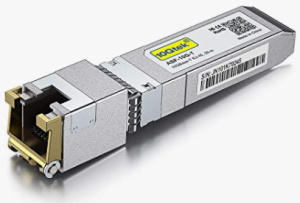A Small Form Factor (SFP) transceiver is a compact hot swappable module that is used in computing for both telecommunication and data communications applications. The increase in the high-speed data transmission due to the demands of the people have led to the fast rise in demand for the SFP modules.
SFP transceivers can be used in a variety of applications. However, sometimes they do not always work according to the way they are intended to. When this happens, it may be a good idea to determine why the SFP module is not working. If you are a newbie to the transceiver world, and it happens that your module stops working, this guide will assist in providing a number of solutions.
Common Reasons Why SFP Transceivers Stop Working
1. Compatibility Issues
2. Defective Components
3. Excessive Dust
1. Compatibility Issues
Most of the manufactures guarantee a 100 percentage compatibility, and this may not always be the case. Sometimes the device may not be compatible, and you may find yourself troubleshooting it without any tangible results.
If this happens, its solution may be more challenging and may require more technical knowledge that what a typical novice may have. If any part your infrastructure is old, chances may be that the new transceiver has been manufactured with the new technologies. It is thus advisable that you consider replacing the device.
Errors Associated with Compatibility Issues
Transceivers that have compatibility issues may display the following error message.
"% GBIC_SECURITY_CRYPT-4-VN_DATA_CRC_ERROR: SFP in port 123456 has bad CRC
%PM-4-ERR_DISABLE: gbic-invalid error detected on Gi2/1/20, putting Gi2/1/20 in err-disable state."
Detecting Compatibility
In order to detect compatibility issues, most of the transceivers have a burned-in chip that contain information such as the serial number, the security information, and the vendor ID. If the information does not match what is contained in the database, the device will be disabled making the device stop working.
2. Defective Components
At times, the components of the transceiver may burn out prematurely. This may happen to a variety of issues. Most of the vendors often build an automatic shut down to the entire machine in case the machine malfunctions.
The transceivers may equally stop working due to the tear and wear. If any component of the transceiver malfunctions, it is recommended to make a good assessment in order to determine the problem. At times, it is better to buy a new SFP transceiver other than trying the repair on a faulty one.
3. Excessive Dust
Optical devices should not be exposed to dust. Always insert into a dust plug when the SFP modules not in use. When the LC connectors are affected by dust, it may cause the module to stop abruptly working. Dust affect the signal transmission making the optical transceiver stop working.
Diagnosing SFP Module Problems
To properly diagnose SFP transceivers, you need to get the right problem statistics from the browser interface, the Command Line Interface (CLI) or from the Simple Network Management Protocol (SNMP).
Most of the common and diagnosable problems include;
A. Poor Performance
B. Lack of Connectivity
C. Corrupted Software
A. Poor Performance (Excessive Errors)
Possible Cause
This problem is caused by cabling distance exceeding the set distance, the port statistics showing excessive frame check sequence, late collision or alignment errors.
Resolution
1. Reduce the cable length to within the recommended distances
2. See the provided SFP module documentation for cabling guidelines.
B. Lack of Connectivity
Possible Cause - This problem relates to the cabling. The use of bad or incorrect cable, incorrect cable wiring, or a cable having loops, may result in this type of problem.
Resolutions
1. Verify to make sure that the pin outs are correct for the proper application of the cables.
2. Replace the used cable with a tested good cable
3. Wait for 30 seconds for the LED to turn Green.
C. Corrupted Software
There are two issues associated with corrupted software. These are;
(a) The port is placed in an error-disabled state after the SFP is inserted.
Possible cause - This problem is caused by the use of a bad transceiver.
Resolution - Remove the SFP transceiver from the port and replace it with an approved module.
(b) Does not Recognize the SFP Module
Possible Cause - This problem generally relates to the SFP installation. The module may be installed upside down or does not snap into the slot.
Resolution
1. Verify that the module is not inserted upside down.
2. Remove the SFP module
and inspect for any physical damage to the connector, the module or the module slot.
3.
Replace the used SFP module with a known good one.
The SFP transceivers may stop working because of a number of reasons. It is always a good advice and practice to know why the module is not working. If you try to fix any problem with prior knowledge, you will simply be doing a trial and error method without making the proper diagnosis. Once you make an identification of why the transceiver is not working, it will be easier to determine a better solution.
The author is a product manager in telecom field. You may reach her at carolinetour12@yahoo.com and visit her websites http://en.ofweek.com/telecom Further information about SFP transceivers, check http://en.ofweek.com/ manufacturer/sfp-transceiver
More Network Troubleshooting and Support Articles:
• Putting Your SME Data on the Internet
• How to Connect a Wireless Router
• Structured Cabling - A Detailed Tutorial and Even More!
• Five Free Tools Every Network Administrator Should Have
• How to Setup a Netgear Wireless Router Without Installation Disc
• Structured Network Troubleshooting Methodology Step 6 Verify Full System Functionality and, if Applicable, Implement Preventive Measures
• Steps For Designing a Crisis Management Plan
• How to Design a Highly Reliable Fiber Optic Network
• Data Center and Server Relocation Planning and Execution
• Structured Network Troubleshooting Methodology Step 4 Establish a Plan of Action to Resolve the Problem and Identify Potential Effects

